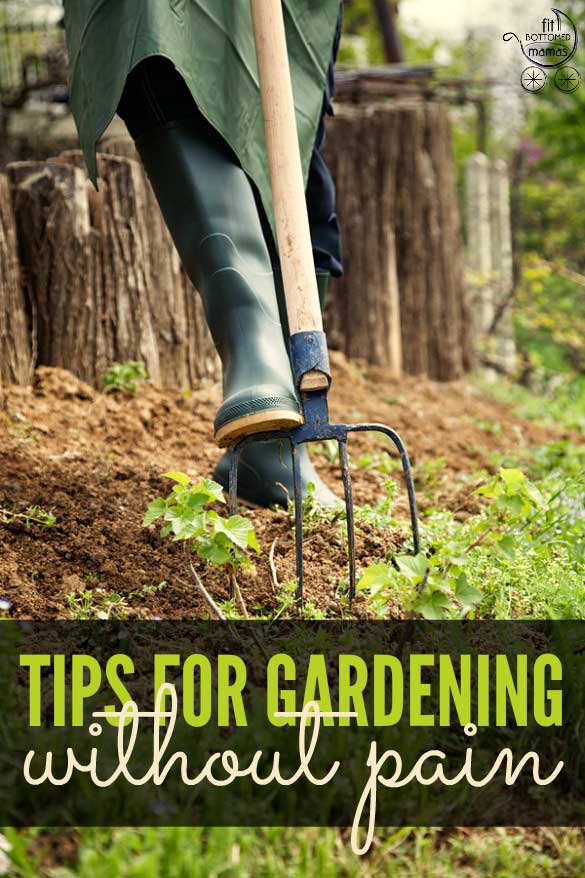Yard Work, Without the Backache
 Yard work is no joke. I just came inside a bit ago after push-mowing the lawn and hacking down a rose bush that had gotten so out of control it was the size of a small country, and my limbs are quivering much like the limbs I chopped down. (Gardening humor, what what!) I never mind yard work, because I’m outside, yay, and I always consider it my workout for the day (two birds, one stone). But whether I’m outside weeding or planting flowers, I never seem to learn how physically demanding it is! And I’m never prepared for the level of soreness I’ll feel the next day.
Yard work is no joke. I just came inside a bit ago after push-mowing the lawn and hacking down a rose bush that had gotten so out of control it was the size of a small country, and my limbs are quivering much like the limbs I chopped down. (Gardening humor, what what!) I never mind yard work, because I’m outside, yay, and I always consider it my workout for the day (two birds, one stone). But whether I’m outside weeding or planting flowers, I never seem to learn how physically demanding it is! And I’m never prepared for the level of soreness I’ll feel the next day.
So when I got these tips from Topical BioMedics with insights on enjoying gardening more with less pain, I had to share. Not only does it tout the amazing benefits of gardening—you don’t just get a beautiful yard—but they’ve got tips on how to help yourself physically prepare for the chore.
Gardening Benefits
It’s the time of year people are tidying up their yards, digging in the dirt, and planting flowers and vegetables in their gardens. However, along with the joy and satisfaction of being active outdoors in nature, gardening also brings with it the risks of pain and injury. Some of the benefits of gardening include being outside in the fresh air and sunshine as well as getting the blood moving. It’s also great form of exercise because it combines three types of physical activity: strength, endurance and flexibility. Perhaps surprisingly, it’s possible to burn the same number of calories gardening for 45 minutes as doing 30 minutes of aerobics.
Here’s another benefit: In a study of more than 3,010 women, researchers from the University of Arkansas found that those involved in yard work and gardening had lower rates of osteoporosis than women who jogged, swam and did aerobics. In addition, spending time in nature can reduce stress, lower blood pressure and relieve muscle tension. There’s no doubt that gardeners place demands on their bodies and—if done improperly—gardening and yard work can lead to muscle and joint pain, repetitive strain injuries, tendonitis and Carpal Tunnel Syndrome, as well as other injuries and accidents.
“Planting, raking, weeding, digging, pruning, stooping, reaching, bending, kneeling, lifting, crouching, carrying heavy debris and operating machinery puts stress on different parts of the body,” says Lou Paradise, president and chief of research at Topical BioMedics, Inc., the makers of natural Topricin Pain Relief and Healing Creams. “Gardeners spend hours performing these activities and without warming up and using proper form, they can lead to a variety of problems such as sprains, strains, twisted ankles, hand and wrist pain, lower back and shoulder pain, foot and knee pain.”
According to the U.S. Consumer Product Safety Commission, last year more than 41,200 people were injured while gardening. For a safer gardening experience, here are a few tips to help stay injury free and safe from potential hazards throughout the gardening season.
Tips for Gardening without Pain
- Warm up/stretch as you would before any physical activity, and then cool down and stretch afterwards.
- Wear gardening gloves to lower the risk of skin irritations/cuts and reduce blister formation, and use kneepads or a foam cushion to make the work less stressful on knees.
- Dress to protect yourself from lawn/garden pests and the hot sun. Wear long-sleeved shirts and long, light-colored pants made from breathable cotton, tuck pants into socks or boots, and check yourself and family members for ticks. Wear a hat and sunglasses, and use a sunscreen.
- Wear goggles when doing things like weed-whacking or chipping and ear protection when using loud equipment.
- Stay hydrated by drinking lots of water throughout the day. Remember that you’re outside in the heat, working up a sweat and perspiring.
- Use ergonomically designed tools, or ones with padded handles that are kinder to hands. Keep your “tools of the trade” in tip-top shape by making sure your power equipment is working properly and your tools are sharpened and properly stored.
- Do not mow grass when it’s wet and slippery. Before mowing, walk around the yard, checking for sticks, stones, toys and other foreign objects that could shoot out from under the mower.
- Work at a steady, constant speed, take breaks often, and be sure to change positions every 10 or 15 minutes to avoid overusing any one muscle group.
Aches and pains don’t have to interfere with summer gardening when you practice prevention and follow activities/injuries with appropriate treatment protocol. If you do feel some pains, Topricin Pain Relief and Healing Cream is a favorite treatment for gardeners. It can be applied prior to outdoor activities to prevent pain, and it can be applied as a barrier to poison ivy!
Are you surprised by the aches and pains after a long day of yard work? —Erin
